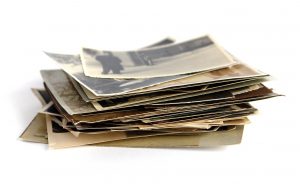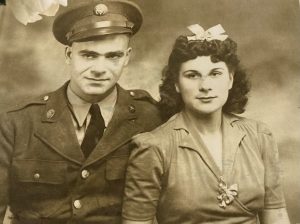As a child, one of my favorite past times was sorting through my family’s old, black and white photographs that had been passed down from multiple generations.
I romanticized the pictures of grandfather, in his World War II military uniform, and my grandmother, his young bride. I chuckled at looking at my own father as a gawky teen and was awestruck by looking at my great-grandparents in their turn of the century attire.
Some pictures were easily identifiable, labeled with a handwritten date or location and sometimes, with a name written in messy cursive on the back. But, more often than not, I’d spend hours trying to figure out exactly who the mysterious folks in these photos were. Like putting together pieces of a puzzle, I used clues such as the fashions people wore, the style and size of the photo paper, or simply trying to jog my older relatives’ memories to learn who exactly was that little baby obscured in the torn photo.
While fascinating to the history buff in me, I kept wondering how these irreplaceable photos were not treated with more care or how they could be so hastily tossed in a manila envelope and forgotten. Fortunately, today we know so much more about how to preserve these precious family mementos and have more options, such as digitizing, to keep our photos safe and organized.
How to Preserve Photos: A Few Tips
Whether you are in possession of recently printed modern photos taken from your iPhone or are sorting through delicate, vintage family photos, here are a few tips to keep in mind to preserve older photos and some ideas to keep the newer ones safe for future generations too.
Getting Organized & Proper Storage
To try to avoid having an ever-growing stack of unidentifiable old photographs (and new ones too!) it is helpful to get as organized as possible. Some suggestions by AARP and HP are:
- Sort out your photos is a clean, dry area to determine what is worth saving. Remember to use white, cotton gloves when handling photos, slides and negatives as fingerprints can cause permanent damage or leave a stain.
- Remove what you safely can from albums (chemicals used in photo albums often deteriorate with time and could damage photos) and frames (which can crack or get dusty).
- Write down any identifying information, or if there are old photos with original writing, make photocopies and attach to any copies you make. This will provide additional proof for identification from an original source and preserve handwriting. (You can use an archival felt-tipped pen and write on the edges for newer photos, but should never use a ballpoint pen on any photo.)
- Use acid-free, archival storage boxes to store original photos. Drop front boxes that are big enough so photos can be stored flat without creasing or bending is generally best. If using albums, use ones with sleeves and made with acid-free paper, and avoid adhesives like magnetic pages, tape or glue.
- If you want to display an old photo, be sure to have it matted and mounted under archival glass by an experienced framer. Also, do not hang the photo in a location that will be exposed to direct sunlight.
- It is best not to store old pictures in attics, basements or garages, where humidity and temperature can fluctuate, or in areas that can be prone to water leaks.
- According to the National Archives, store photos in a location that has a temperature below 75 degrees Fahrenheit. The lower the temperature, the longer the items will last. Cooler temperatures can also slow the rate of chemical decay.
- Keep photos in a location with a relative humidity below 65%, but above 15%. High humidity can increase the likelihood of mold growth and insect activity. Low humidity can cause brittleness.
Digitizing
Before life with smartphones equipped with cameras, most of us had to rely on an actual camera that only had one function – to take photographs! And, we did not have the luxury of deleting or editing that not-so-perfect photo.
But, modern technology now enables us to take those old photos and breathe new life into them through digitizing. When it comes to preserving old photographs, it is usually recommended to make digital copies, which you can do yourself with a desktop scanner (or a scanner app from a smartphone), or you can send them out to a professional company.
If you are taking the do-it-yourself route, you can use a high-quality scanner and burn the photos on a CD, flash drive, or make additional copies. HP recommends:
- Set your scanner to color even if the pictures are black and white;
- Set the scanner to a photo setting rather than a document setting; and
- Use a scanner with a resolution of 600 DPI or greater.
If you would like to send out your photos, negatives or slides to an online service specializing in digitizing photos, you have a number of companies to choose from that offer a variety of prices and services.
Here are a few popular scanning services to check out:
1. ScanCafe offers scanning services for photos, movies, video, audio, and photo restorations. All completed items can be reviewed online and any unwanted images can be rejected prior to payment.
2. ScanDigital offers a wide range of scanning services and delivery options including scanning of printed photos to VHS, Super 8, 8mm or 16mm film to DVD.
3. EverPresent offers a variety of digitized services and has local Connecticut locations. They offer home pick-ups, mail orders, and drop off options.
4. Memories Renewed offers fast, high resolution scans and restoration services. You can even send them entire photo albums with images marked off that have to be scanned.
5. Dijify is known for not just its scanning services, but photo restoration skill.
As the saying goes, “Every picture tells a story!”
Preserving and documenting your family photos is a vital way to protect and share information for future generations about who you are, where you came from and what you did.
It’s important to do your best to keep your family photographs cared for and organized so you can share your family’s story. And, now you have more options than ever before to do just that.
Related Posts:
6 Surprising Benefits of Researching Your Family History
7 Ways to Unload Your Family Heirlooms
Write a Letter: 3 Reasons It’s More Important Than Ever
Bringing Back the Sunday Dinner
Need a Scanner? There’s a Hidden Gem in the Palm of Your Hands
Why the Kitchen is the Heart of Your Home
 Connecticut Estate Planning Attorneys Blog
Connecticut Estate Planning Attorneys Blog




